For many teams, the annual budget is a document that quickly becomes disconnected from the day-to-day work it’s meant to guide. This gap between financial plans and project execution creates friction, forcing leaders to make decisions with outdated information. The right budget planning software closes this gap by connecting financial data directly to your team’s workflows, turning your budget into a live, strategic guide.
This guide will walk you through the best budget planning software available, including monday work management. We’ll explore what separates a good platform from a great one, how to test drive your options, and the key features that empower teams to manage finances with confidence.
Try monday work managementWhat is business budget planning software?

Think of budget planning software as your team’s financial command center. It shifts your focus from just recording what you’ve already spent to strategically planning what you’ll do next, turning budgeting into a forward-looking game plan instead of a look in the rearview mirror.
This isn’t about replacing spreadsheets; it’s about outgrowing them entirely. By automating expense tracking and connecting every department’s spending to your main goals, the right platform gives everyone a comprehensive view of the financial big picture. This turns budgeting from a siloed, stressful chore into a collaborative process that builds confidence.
The real win is gaining total financial visibility and the agility to act on it. You get real-time insights to smartly allocate resources where they’ll have the most impact and use predictive tools to anticipate future needs. It’s how you ensure every dollar is working toward your strategic objectives, keeping your team aligned and ahead of the curve.
15 top software solutions for budget management
The best budget planning software transforms your financial strategy from a static plan into an actionable, real-time roadmap. Instead of juggling disconnected spreadsheets and manual processes, a top-tier platform brings all your financial data into one centralized hub — directly linked to your team’s everyday workflows. This means every decision is backed by up-to-date numbers, not outdated estimates.
What sets great platforms apart? It’s total visibility through customizable dashboards, powerful automations that eliminate repetitive work, and real-time insights that show exactly how every project or task impacts your bottom line. Here’s a quick comparison table of the top budget software available:
| Platform | Use case | Free plan? | Notable feature | Starting price |
|---|---|---|---|---|
| monday work management | Cross-departmental teams linking budgets, projects, and KPIs in one place | Yes | Custom budget boards with instant variance calculations and 200+ automations | $9/seat/month |
| Asana | Marketing & operations teams tying campaign spend to projects | Yes | Portfolios for tracking budgets and project health in real time | $10.99/user/month |
| Trello | Startups & nonprofits visualizing small budgets simply | Yes | Kanban boards with Budget Power-Up for charts & expense categories | $5/user/month |
| Smartsheet | Enterprises managing multi-department budgets with robust reporting | No | Advanced automation and integrations with Salesforce, M365, Google | Contact sales |
| Wrike | Professional services & agencies balancing client budgets and time | Yes | Financial fields for planned vs. actual costs and custom hourly rates | $10/user/month |
| ClickUp | Growing companies unifying tasks, budgets, & time tracking | Yes | Real-time dashboards with customizable budget widgets | $7/user/month |
| Basecamp | Small businesses & creatives needing simple, flat-rate collaboration | No | Team communication with basic financial oversight via Timesheet add-on | $15/user/month |
| Zoho Projects | SMBs in the Zoho ecosystem needing integrated budget & invoicing | Yes | Multiple budget tracking methods and seamless Zoho integrations | $4/user/month |
| Nifty | Consulting teams managing billable hours & budgets in one workspace | Yes | Dynamic time-based budget calculations and multi-currency support | $7/member/month |
| Todoist | Freelancers/solopreneurs turning budgets into recurring habits | Yes | YNAB-powered templates and recurring budget task reminders | $4/month |
| Miro | Design/product teams visualizing budgets in collaborative sessions | Yes | Interactive budget boards and real-time collaboration tools | $8/member/month |
| Hive | Agencies combining communication, time, and budget tracking | No | Integrated time tracking & budget management in flexible project views | $12/user/month |
| Notion | Startups & individuals needing fully customizable budget templates | Yes | 900+ templates, custom databases, and flexible dashboards | $10/member/month |
| Airtable | Data-driven teams connecting expenses & forecasting in databases | Yes | Linked records, rollups, and pre-built budget templates | $20/user/month |
| Microsoft Project | Enterprise PMOs handling complex initiatives with strict controls | No | Advanced Gantt charts and earned value financial analysis | $10/user/month |
Now, let’s look deeper into each solution, including its key features, pricing model, and considerations.
1. monday work management
Transforming budget planning from a maze of scattered spreadsheets into a streamlined, visual command center, this platform empowers teams to keep their finances organized and goals within reach. With highly customizable budget management workflows, monday work management built for teams who want to track expenses, forecast spending, and ensure financial accountability across every project.

Use case: Cross-departmental teams who want budgets, projects, and KPIs in one place without toggling between apps
Key features
- Custom budget boards to track planned vs. actual spending, with instant variance calculations that highlight where you’re over or under budget
- Automated approval workflows that keep budget changes aligned with your internal processes and ensure every adjustment is properly authorized
- Real-time updates and collaboration features, allowing your team to comment, tag stakeholders, and resolve issues directly within the budget workspace
Pricing
- Free: $0 forever for up to 2 seats with 3 boards and basic budget tracking features
- Basic: $9/seat/month (billed annually) with unlimited items and 5GB storage
- Standard: $12/seat/month (billed annually) including timeline views and 250 monthly automations
- Pro: $19/seat/month (billed annually) featuring advanced formula columns and 25,000 monthly automations
- Enterprise: Custom pricing with enterprise-scale features and advanced security
- Annual billing saves 18% compared to monthly plans, with nonprofit discounts available.
Why it stands out
- Seamlessly integrates budget planning with project management, eliminating the need for separate financial software
- No-code customization allows teams to build budget workflows without technical expertise
- Real-time collaboration features keep all stakeholders aligned on financial goals and spending decisions
Advanced AI features
- Predicts spending patterns and suggests budget optimizations using AI-powered insights, so your team can stay ahead of shifting financial needs.
- Automatically categorizes expenses and highlights potential cost-saving opportunities across projects, reducing manual analysis and surfacing actionable recommendations.
- Triggers instant budget alerts when spending approaches set thresholds, ensuring you never miss a critical moment to adjust course or reallocate resources.
Automations and integrations
- Automate your budget workflows with 200+ ready-to-use automation recipes — think instant notifications for budget approvals, real-time alerts when spending nears your limits, and automatic updates to your financial dashboards with every new expense
- Connect your financial ecosystem with leading accounting and ERP platforms like QuickBooks, Xero, and Sage
- Integrate with your favorite tools, including Slack for instant budget notifications to Google Drive for centralized financial document storage, and Zoom for budget review meetings
2. Asana
Within Asana’s project management ecosystem, teams can orchestrate everything from daily tasks to strategic initiatives. While not a dedicated accounting platform, it provides an organized framework for tracking project costs and monitoring resource allocation. By bringing budget-related tasks and conversations into the same space where work happens, it ensures financial goals stay aligned with project progress.
Use case: Marketing and operations teams who need to tie campaign spend directly to tasks and portfolios
Key features
- Portfolios to monitor the health and budget status of multiple projects at a glance
- Custom fields to track costs, budget estimates, and actual spending on a task or project level
- Workload features to manage team capacity and prevent over-allocation of resources, helping to keep labor costs in check
Pricing
- Basic: Free for individuals or teams just getting started
- Premium: $10.99/month per user (billed annually)
- Business: $24.99/month per user (billed annually)
- Enterprise: Custom pricing available
- Free 30-day trial available
Considerations
- Some advanced budgeting features require integration with third-party apps or paid add-ons
- Customization is powerful but may require initial setup to fully align budget tracking with your team’s workflow
3. Trello
With its signature Kanban-style boards, Trello turns budget tracking into a visual, card-based system that makes financial planning feel less like accounting and more like organizing. The platform’s drag-and-drop simplicity is perfect for small teams and individuals who want straightforward budget management without overly complex features.
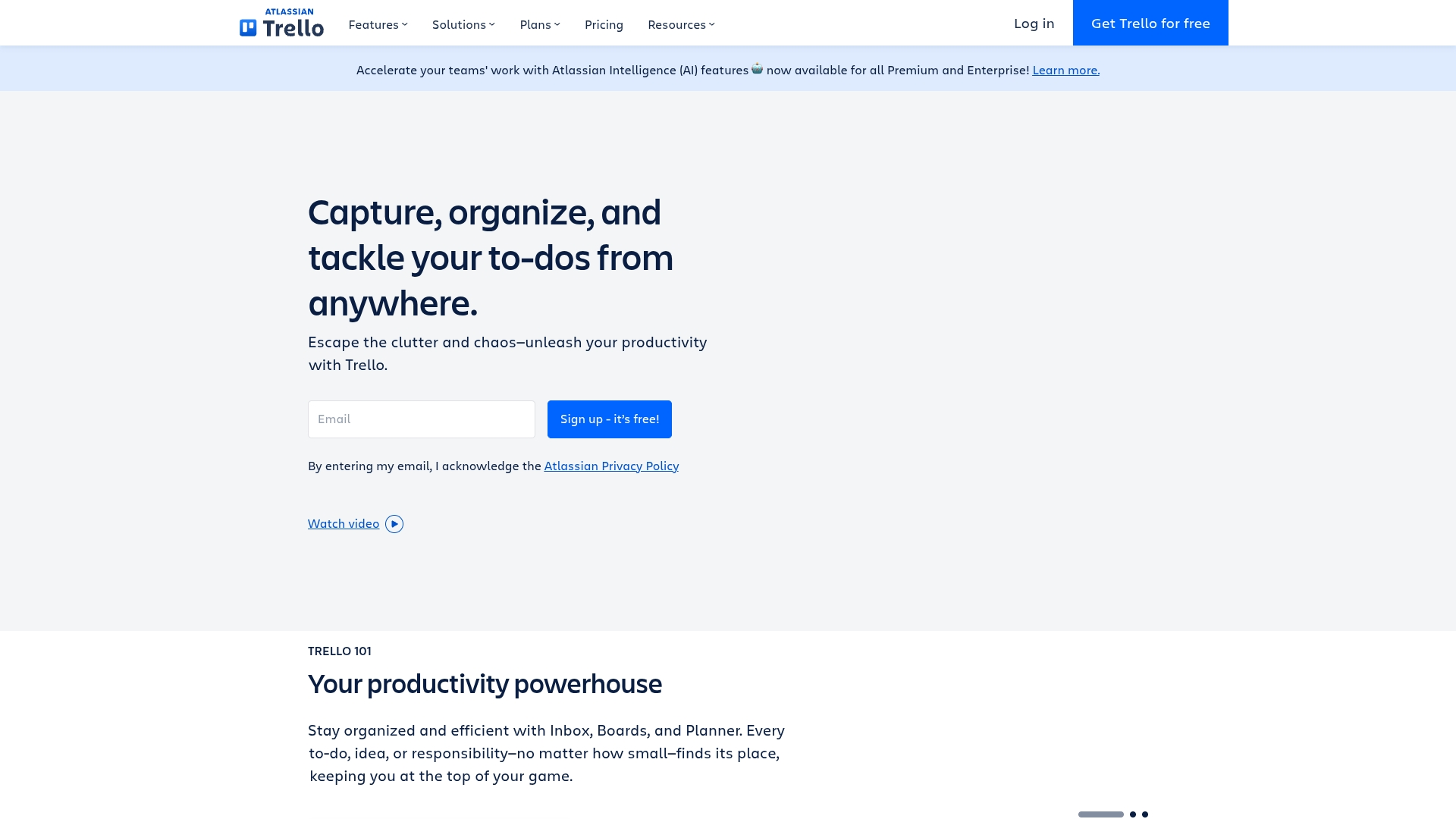
Use case: Startups and nonprofits managing small budgets visually without deep financial complexity
Key features
- Visual budget templates with monthly expense tracking and payment due dates
- Colorful Budget Power-Up that adds charts, dashboards, and expense categorization
- Google Drive integration for attaching receipts and financial documents directly to budget cards
Pricing
- Free: $0 for up to 10 collaborators per workspace with unlimited cards and basic features
- Standard: $5/user/month (billed annually) with unlimited boards and advanced checklists
- Premium: $10/user/month (billed annually) including multiple views and AI features
- Enterprise: $17.50/user/month (billed annually) with organization-wide permissions and SSO
Considerations
- Limited native budgeting features require third-party Power-Ups for advanced functionality
- The Colorful Budget Power-Up costs an additional $2.99/month for comprehensive financial tracking
4. Smartsheet
By blending the familiar interface of a spreadsheet with powerful project management capabilities, Smartsheet streamlines complex budget planning. The platform specializes in enterprise-grade automation and workflow management, making it a strong choice for large organizations that need to track multiple budgets across departments and projects.
Use case: Enterprises managing multiple departments, grants, or funding sources with advanced reporting needs
Key features
- Advanced time, fee, and expense budget tracking with customizable categories (requires the Resource Management add-on)
- Powerful workflow automation to handle tasks like budget approvals and status notifications
- Integrations with popular business platforms like Salesforce, Microsoft 365, and Google Workspace
Pricing
- Pro: For new customers, this plan provides core features for teams of up to 10.
- Business: Unlocks unlimited automations and advanced reporting for growing teams.
- Enterprise: Custom pricing with enterprise-grade security, AI tools, and SAML SSO.
- Advanced Capabilities: Custom pricing for premium add-ons like Control Center and Dynamic View.
Considerations
- Steep learning curve for users unfamiliar with spreadsheet-based project management platforms
- Higher-tier plans or add-ons are required for advanced budget management features, which can be costly for smaller teams
5. Wrike
For teams needing financial oversight directly alongside task execution, Wrike provides comprehensive project management with built-in budget planning capabilities. The platform combines advanced reporting, real-time collaboration, and accounting tool integrations, making it particularly effective for medium to large organizations managing complex projects with strict financial requirements.
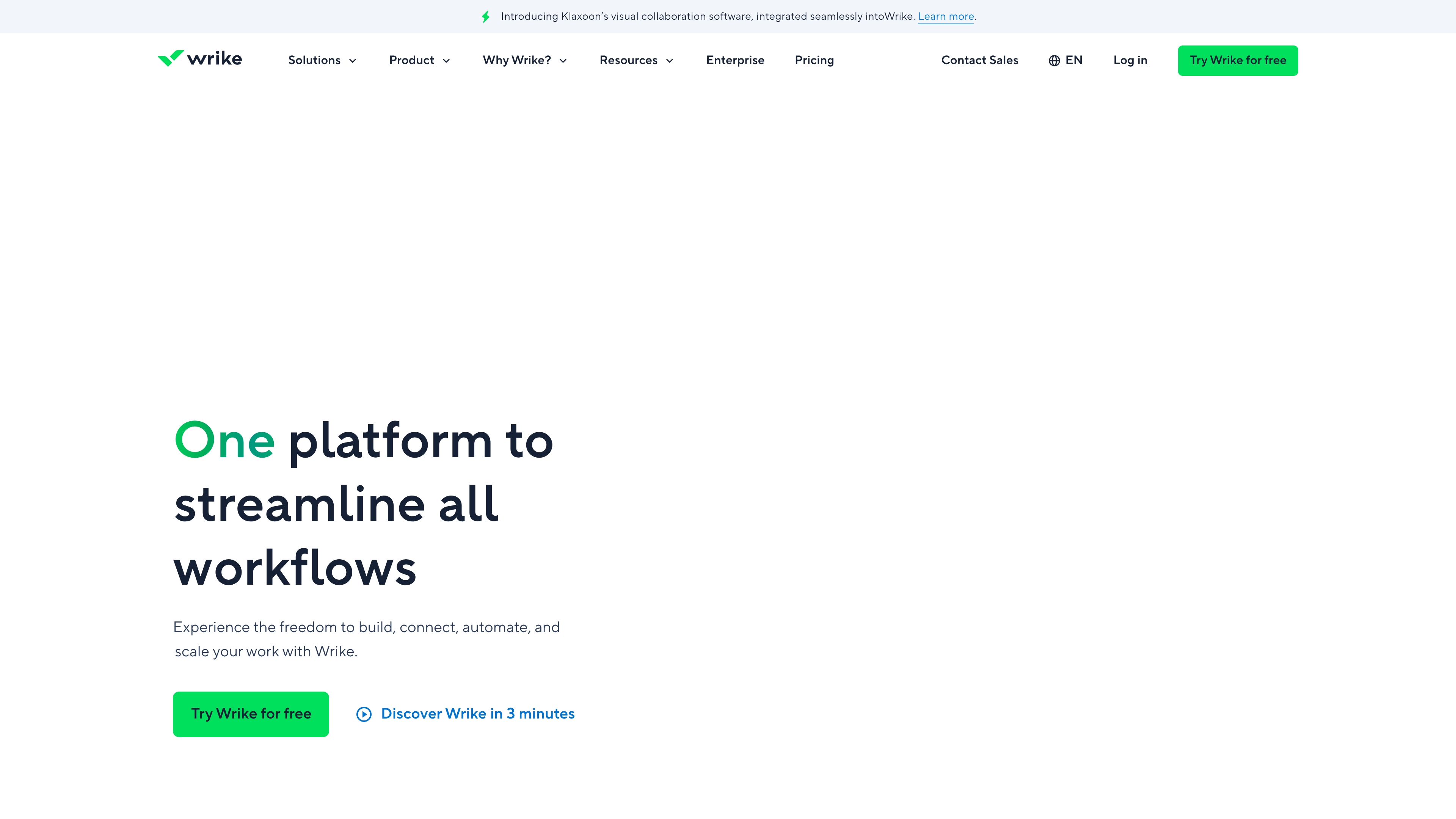
Use case: Professional services and agencies balancing client budgets, time tracking, and project delivery
Key features
- Financial fields that automatically calculate planned versus actual fees and costs across all projects
- Customizable hourly rates for users and job roles with project-specific overrides
- Advanced reporting dashboards that provide comprehensive budget tracking and forecasting insights
Pricing
- Free: $0/user/month for basic task management with limited features
- Team: $10/user/month for small teams with unlimited projects and 2GB storage
- Business: $25/user/month including advanced reporting and resource planning
- Enterprise: Custom pricing with SAML SSO and advanced admin controls
- Pinnacle: Custom pricing with full budgeting features and advanced analytics
Considerations
- Advanced budgeting features are only available in the highest-tier Pinnacle plan, which may be cost-prohibitive for smaller teams
- The extensive feature set creates a steep learning curve that can overwhelm new users initially
6. ClickUp
ClickUp’s all-in-one platform unifies scattered work by integrating project management with budget planning, eliminating the need for multiple tools. This consolidated approach is perfect for teams who want to track finances alongside their project workflows without context switching.
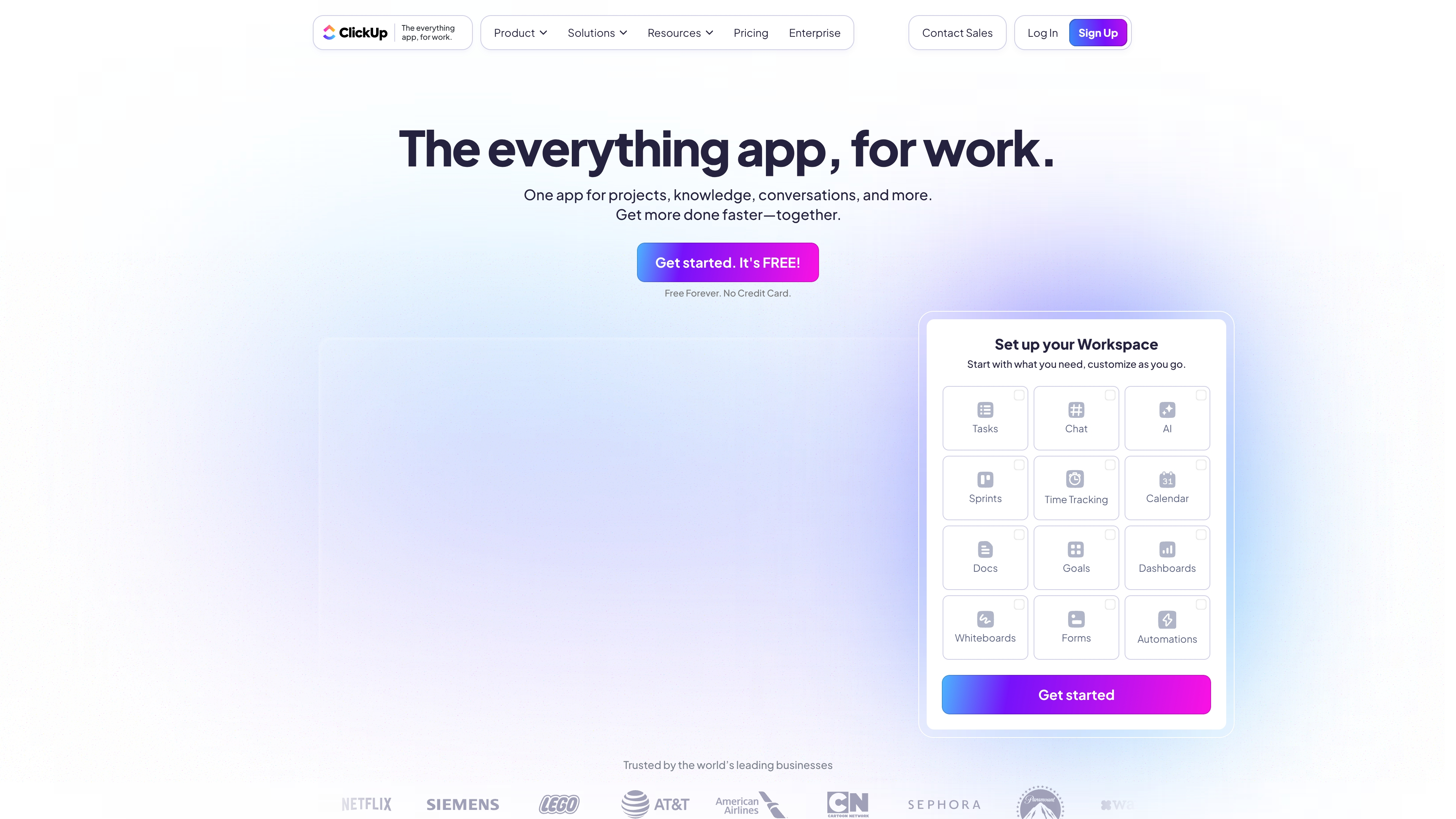
Use case: Growing companies who want to consolidate budgeting, task tracking, and time management in one customizable tool
Key features
- Custom fields for tracking expenses, hourly rates, and budget allocations within tasks and projects
- Real-time dashboards with widgets displaying budget totals, actuals, and variances for instant financial visibility
- Native time tracking combined with billable rates to automatically calculate labor costs against budgets
Pricing
- Free Forever: $0/month (unlimited tasks, basic features)
- Unlimited: $7/user/month (unlimited storage, integrations, time tracking)
- Business: $12/user/month (dashboards, advanced automation, workload management)
- Enterprise: Custom pricing (white labeling, advanced permissions, dedicated support)
Considerations
- Setting up comprehensive budget tracking requires significant initial configuration of custom fields and dashboards
- Lacks advanced financial features like invoicing and payroll that dedicated accounting software provides
7. Basecamp
Prioritizing team communication and collaboration over complex features, Basecamp offers straightforward project management for small businesses and creative teams. It provides an all-in-one solution without the overwhelming bells and whistles of many enterprise-grade tools.
Use case: Small businesses or creative shops that need simple, flat-priced collaboration with light financial oversight
Key features
- Message boards and group chat for streamlined team communication
- To-do lists and card tables for basic task management
- File sharing and document storage in one centralized location
Pricing
- Basecamp: $15/user/month. This plan includes 500 GB of storage and unlimited projects. Clients and guests can be added for free.
- Basecamp Pro Unlimited: $299/month (billed annually) or $349/month (billed monthly). Flat-rate plan includes unlimited users and 5 TB of storage.
- A Timesheet add-on for time tracking is included in the Pro Unlimited plan and can be added to the standard plan for an extra $50/month.
Considerations
- Lacks dedicated budget planning tools, though its Timesheet add-on helps with tracking billable hours
- Limited customization options compared to more robust work management platforms
8. Zoho Projects
As part of Zoho’s extensive business suite, Zoho Projects provides comprehensive project management with built-in budget tracking and financial controls. This makes it a powerful and affordable option for growing businesses that need robust budget planning software without breaking the bank.
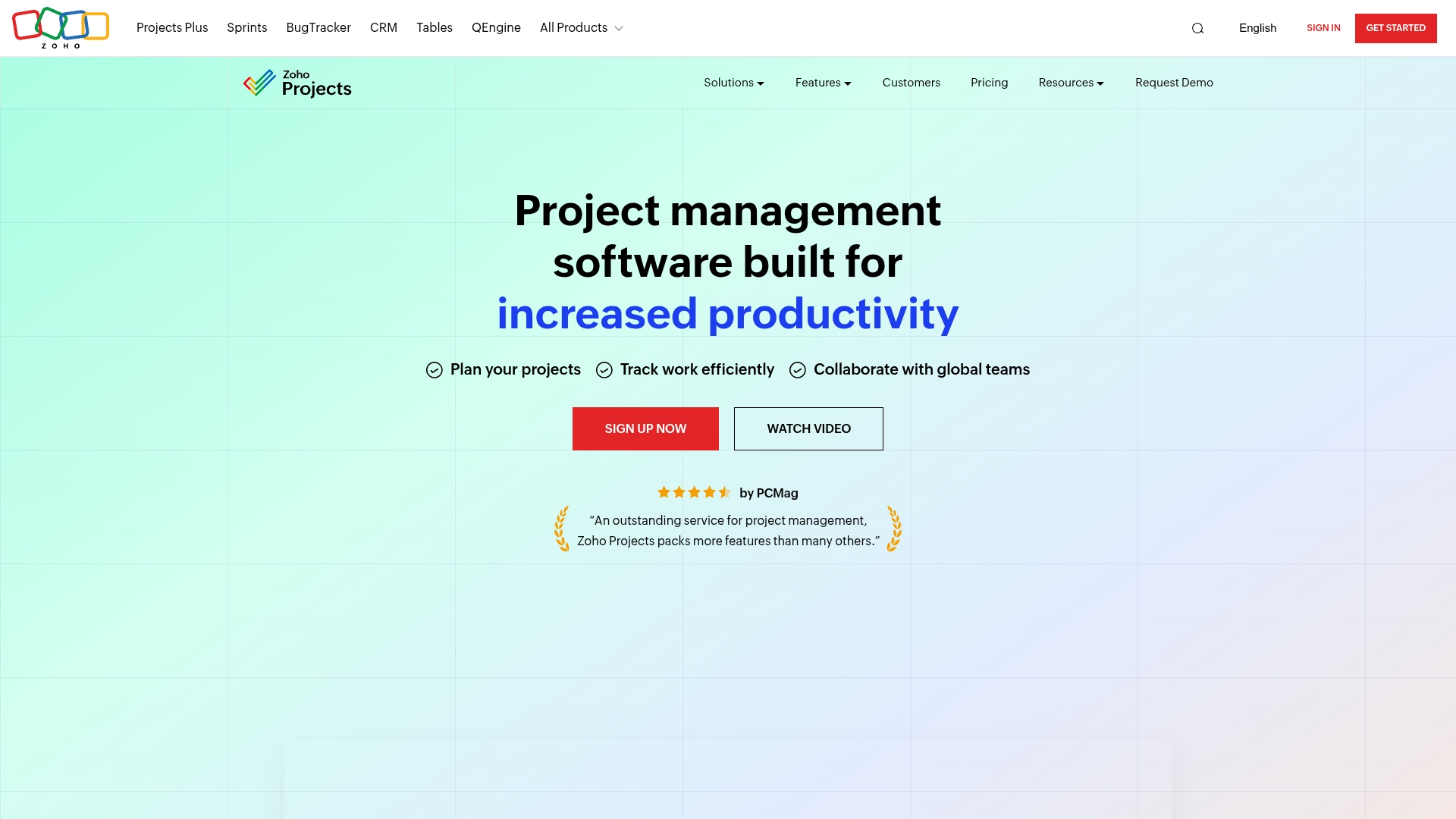
Use case: SMBs already in the Zoho ecosystem who want affordable budget control tied into invoicing and billing
Key features
- Multiple budget tracking methods (project-level, task-level, or user-based) with flexible billing options
- Real-time planned vs. actual reporting with threshold alerts and email notifications when spending exceeds limits
- Seamless integration with Zoho Invoice and Zoho Books for streamlined expense management and client billing
Pricing
- Free Plan: $0/month for up to 5 users with 3 projects and basic features
- Premium Plan: $4/user/month (billed annually) with unlimited projects, time tracking, and budget management
- Enterprise Plan: $9/user/month (billed annually) with advanced features, custom fields, and single sign-on
- Free 10-day trial available for paid plans
Considerations
- Budget planning features are only available in paid plans, limiting access for very small teams
- Integration works best within the Zoho ecosystem, which may not suit businesses using other accounting software like QuickBooks
9. Nifty
Nifty integrates budget tracking directly into its project management workspace, helping teams keep an eye on financial health without leaving their primary tool. It offers real-time cost tracking through time logs and hourly rates, while its flexibility with custom fields allows you to build a budget system that fits your project’s needs.
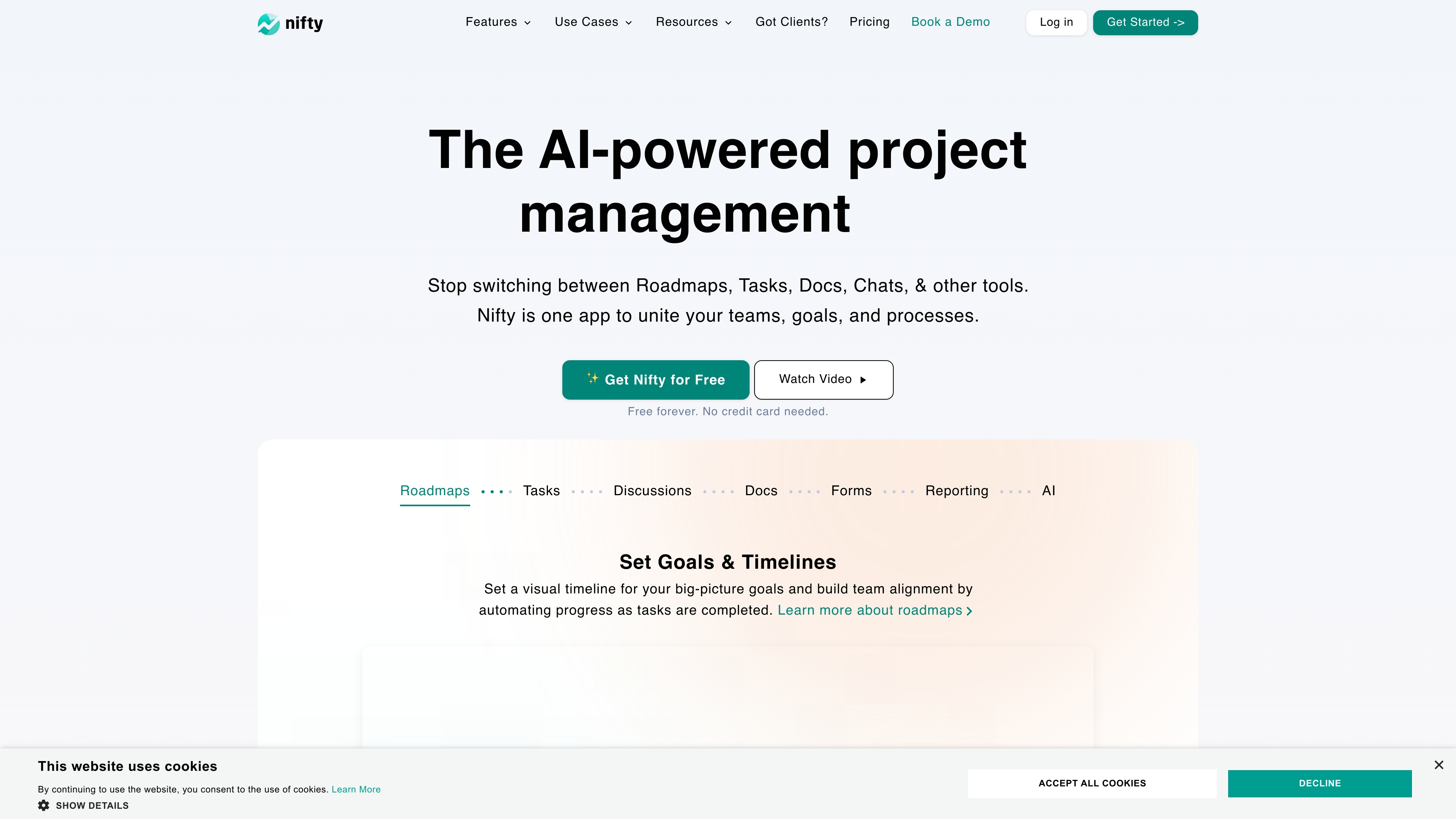
Use case: Consulting teams who want to manage billable hours, project timelines, and budgets in one streamlined workspace
Key features
- Dynamic budget calculations that multiply tracked time by hourly rates for automatic cost tracking
- Multi-currency support including USD, EUR, GBP, and 10 other international currencies
- Custom fields and formula capabilities for advanced budget planning and financial reporting
Pricing
- Free: $0 forever for unlimited members, with 2 active projects, 100 MB storage, and basic features
- Personal: $7/member/month with budget tracking and 40 active projects
- Pro: $10/member/month with workflow automations and 100 active projects
- Business: $16/member/month with unlimited projects and advanced permissions
- Enterprise: Custom pricing with dedicated success management
- Free 14-day trial available with no credit card required
- Annual plans receive up to a 45% discount
Considerations
- Budget tracking features are only available on paid plans, limiting access for teams testing the platform
- As a smaller market player, Nifty may have fewer native integrations compared to established competitors and relies more on Zapier
10. Todoist
Through its partnership with YNAB (You Need a Budget), Todoist reframes personal finance management as a simple, habit-driven process. The platform specializes in turning financial goals into actionable tasks, making it ideal for individuals who want to integrate budgeting into their daily productivity workflows.
Use case: Freelancers or solopreneurs who want to turn budgeting into repeatable, task-driven habits
Key features
- Step-by-step budgeting template developed in partnership with YNAB for structured financial organization
- Recurring task reminders for bills, budget reviews, and financial check-ins to build consistent habits
- Custom project creation for different budget categories with subtasks for detailed expense tracking
Pricing
- Beginner: Free forever with 5 personal projects, task reminders, and basic integrations
- Pro: $4/month (billed annually at $48) with 300 personal projects, calendar layout, and AI Assistant
- Business: $6/month (billed annually at $72) with team workspace, up to 500 projects, and team collaboration features
- 20% savings available with annual billing
Considerations
- Lacks dedicated budgeting features like automatic bank syncing, transaction categorization, or financial reporting
- Requires manual input and tracking of all financial data, making it less suitable for complex financial situations
11. Miro
Miro’s infinite whiteboard provides a canvas for visual collaboration, turning budget planning from a spreadsheet-bound task into an interactive, real-time strategy session. The platform specializes in turning financial data into interactive boards where teams can brainstorm, map out strategies, and track expenses together.
Use case: Design and product teams who want to visualize budget trade-offs in brainstorming and planning sessions
Key features
- Visual budget templates with customizable sections for project goals, income sources, and expense tracking
- Real-time collaboration tools that let multiple stakeholders contribute to budget planning simultaneously
- Export capabilities to share budget data in various formats like PDF or image files for reporting
Pricing
- Free: $0 with unlimited members, 3 editable boards, and 5,000+ templates
- Starter: $8/month per member (billed annually) with unlimited boards and advanced exports
- Business: $16/month per member (billed annually) with multiple workspaces and advanced admin features
- Enterprise: Custom pricing from 30 members with organization-wide security and premium support
Considerations
- Visual-first approach may not suit teams that prefer traditional text-heavy financial documentation
- Mobile app functionality is limited compared to desktop and web versions, which could impact on-the-go budget reviews
12. Hive
Built on user feedback, Hive’s democratically-developed platform streamlines scattered project work by putting users in the driver’s seat. The platform specializes in flexible project views and integrated communication, making it ideal for marketing teams and creative agencies who need both collaboration and customization.
Use case: Agencies and creative collectives that want to combine communication, time tracking, and budget tracking
Key features
- Multiple project views (Kanban, Gantt, calendar) with customizable workflows for different team preferences
- Integrated time tracking and budget management that automatically calculates project costs based on billable hours
- Native chat messaging and email integration to streamline team communication within projects
Pricing
- Solo: $12/user/month (billed annually)
- Teams: $18/user/month (billed annually)
- Enterprise: Custom pricing available
- Additional apps like Resourcing and Timesheets available as paid add-ons
Considerations
- Essential budget planning features require paid add-ons, which can increase overall costs significantly
- Mobile app lacks the full feature set available on desktop, limiting on-the-go project management
13. Notion
Notion’s strength lies in its unparalleled flexibility, allowing users to construct a unified, completely custom budget planning system that adapts to their unique money management style. The platform specializes in flexible database creation and template customization, making it ideal for individuals and teams who want complete control over their financial tracking experience.
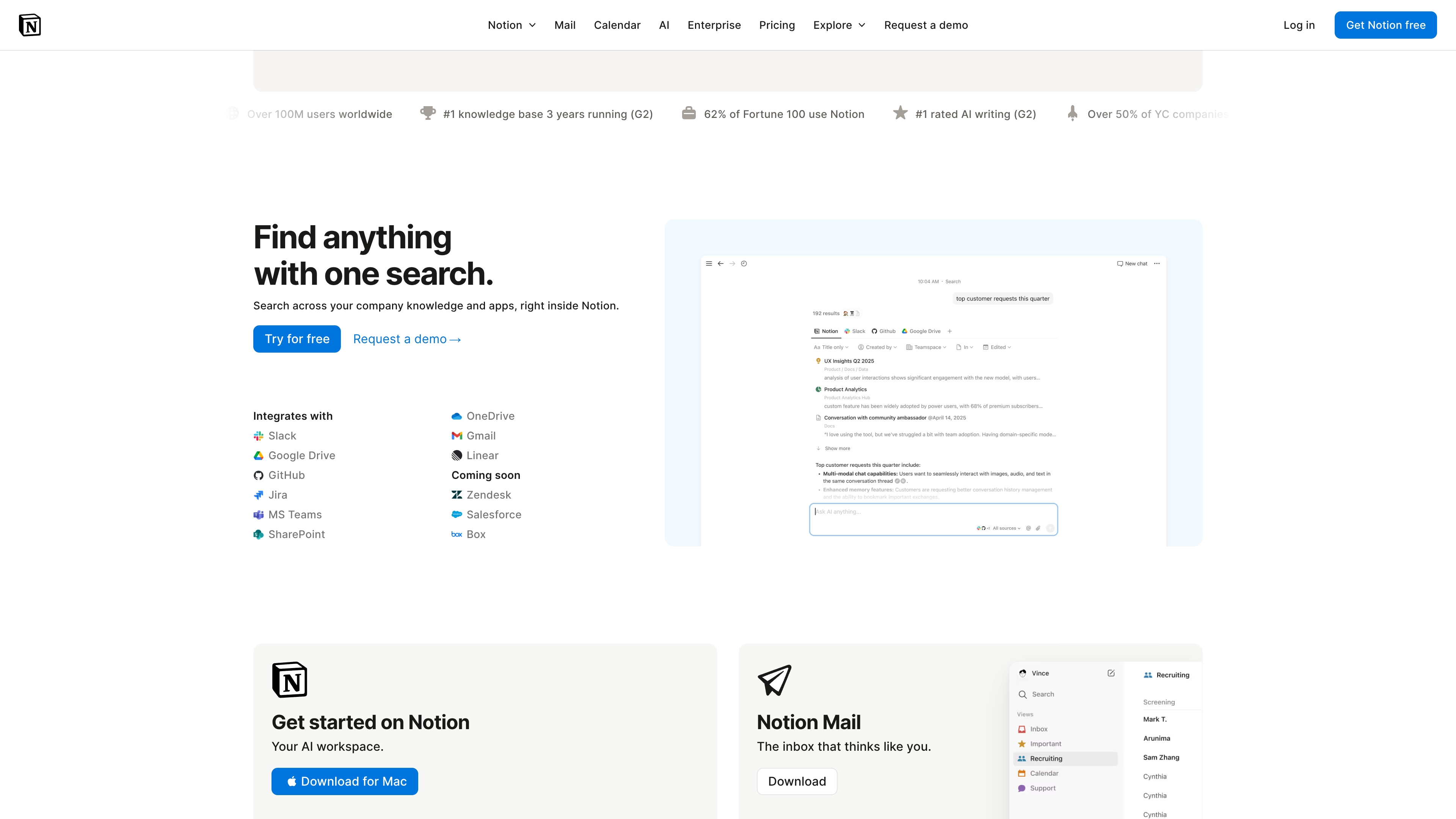
Use case: Startups and individuals who want to fully customize their own budget templates and financial databases
Key features
- Over 921 budget-related templates from Notion and its community, including expense trackers, subscription managers, and cashflow monitors
- Custom database creation with formulas, rollups, and multiple view options (calendar, board, table)
- Integrated dashboard capabilities that combine budgeting with other life management areas like goals and projects
Pricing
- Free: $0 per member/month with unlimited storage for individuals, a limited trial for teams, and a trial of Notion AI
- Plus: $10 per member/month with unlimited collaborative blocks, file uploads, and a trial of Notion AI
- Business: $20 per member/month with SAML SSO and Notion AI included
- Enterprise: Custom pricing with advanced security, compliance features, and Notion AI included
- Custom domains: $8/month per domain (billed annually) or $10/month per domain (billed monthly) as an add-on
Considerations
- Primarily relies on manual data entry, though some community-created templates offer automated bank syncing
- Limited financial calculation and visualization features compared to dedicated personal finance management software
14. Airtable
Airtable elevates the simple spreadsheet into a powerful relational database, giving teams the flexibility to build custom budget trackers that perfectly match their workflows. The platform is ideal for teams who need more than basic budgeting apps but want something more intuitive than complex accounting software.
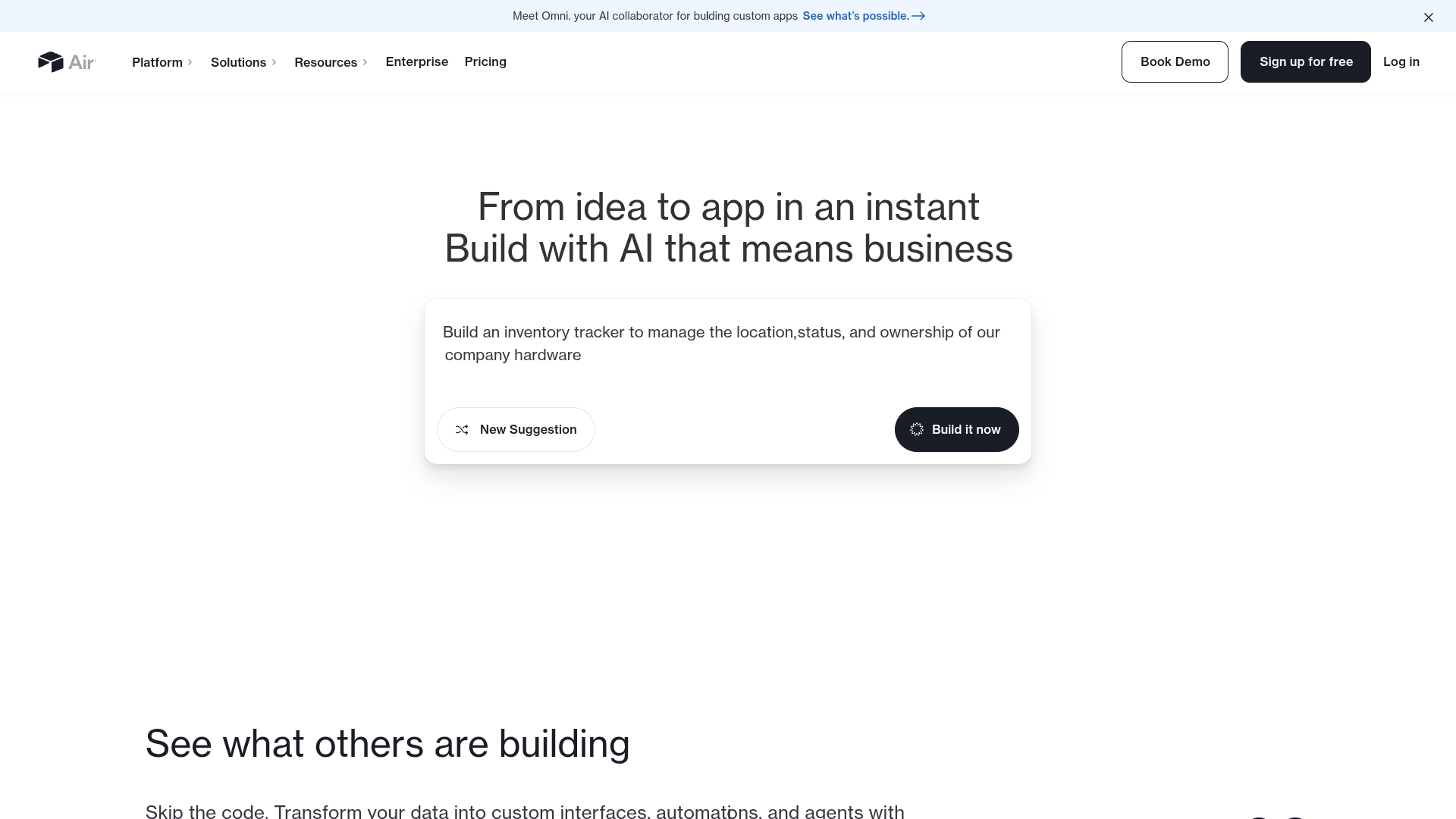
Use case: Data-driven teams who want relational budgets connecting expenses, categories, and forecasting in one flexible system
Key features
- Linked records and rollup fields that automatically calculate totals across different budget categories
- Multiple view options including calendar views for bill tracking and Kanban boards for expense approvals
- Pre-built budget templates with zero-based budgeting methodologies and customizable fields
Pricing
- Free: $0/month (up to 1,000 records per base, 5 editors)
- Team: $20/month per user (billed annually, $24 monthly)
- Business: $45/month per user (billed annually, $54 monthly)
- Enterprise Scale: Custom pricing (contact sales)
Considerations
- Requires manual data entry since it doesn’t automatically import bank transactions
- Can become complex for users who just need simple personal budgeting software without advanced database features
15. Microsoft Project
Designed for complex enterprise initiatives, Microsoft Project offers comprehensive project and budget planning capabilities deeply integrated within the Microsoft 365 ecosystem. The platform is ideal for large organizations managing multi-faceted projects with strict budget requirements.
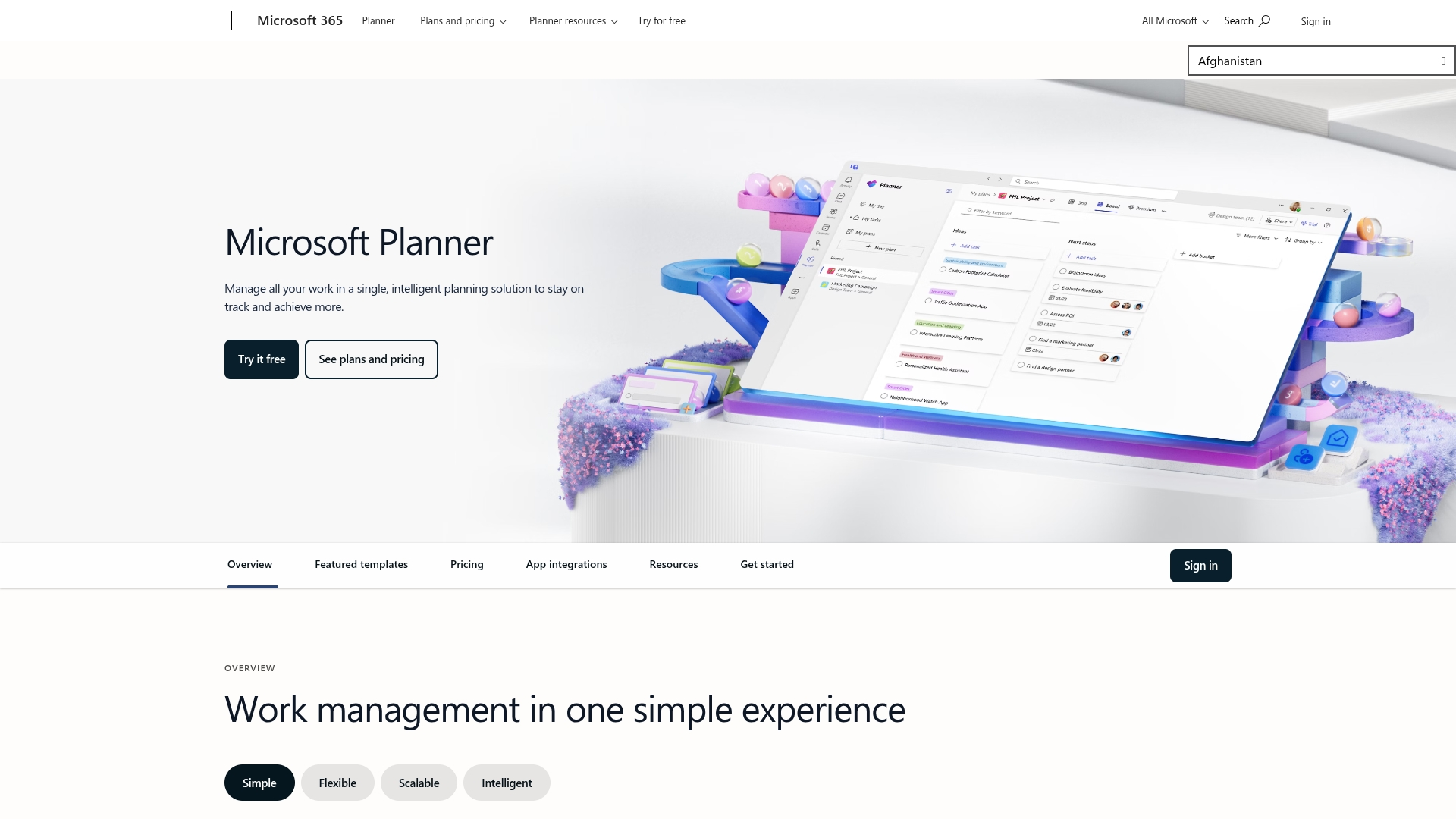
Use case: Enterprise PMOs managing large-scale initiatives with strict cost controls and resource allocations
Key features
- Advanced Gantt charts with resource allocation and budget tracking capabilities
- Earned value analysis tools for comprehensive financial performance monitoring
- Seamless integration with Microsoft 365 applications including Teams and SharePoint
Pricing
- Project Plan 1: $10/user/month (annual commitment)
- Project Plan 3: $30/user/month (annual commitment)
- Project Plan 5: $55/user/month (annual commitment)
- Free trial available for all plans
Considerations
- Steep learning curve, particularly for desktop versions, can overwhelm new users
- Limited accounting and invoicing software capabilities compared to dedicated financial software
What separates good tools from great budgeting software
The difference between good and great budgeting software is how well the platform transforms budgets from static spreadsheets into dynamic playbooks that guide every decision. The best tools keep teams aligned, spending accountable, and financial decisions confident.
- Real-time data and forecasting: Great platforms give you live visibility into financials, so you can reallocate resources as conditions shift. Forecasting tools turn historical data into actionable predictions, letting you plan for what’s next instead of reacting to what already happened.
- Collaboration in online budgeting platforms: Teams need a single source of truth where everyone can see, update, and comment in real time. With shared dashboards and in-context discussions, decision-making moves faster and debates shrink from weeks of email chains to quick, data-backed conversations.
- Integrations with accounting software and ERPs: Modern platforms connect directly to accounting systems like QuickBooks or Xero, or enterprise ERPs like SAP. This flow of data eliminates manual entry, reduces errors, and ensures your budget reflects the actual numbers.
- Enterprise-grade security and compliance: Strong platforms provide multi-level permissions, detailed audit trails, and certifications like SOC 2 or ISO 27001. With compliance baked in, your team can move fast without sacrificing peace of mind.

How AI and budget automation tools improve budget planning

Historically, budgeting was about crunching last quarter’s numbers in spreadsheets — an approach that left teams reacting to what already happened, not shaping what comes next. With the rise of AI in work management, that paradigm has fundamentally changed. AI-powered platforms now bring true foresight to the budgeting process: They can surface financial risks before they become issues, flag unusual spending patterns for instant review, and forecast future needs with remarkable accuracy based on real-time data.
Automation further transforms budget planning by eliminating the repetitive, manual grind — think approvals, updates, reminders, and even cross-team communication. With a platform like monday work management, you can set up rules to auto-approve budget changes, trigger instant alerts when spending approaches or exceeds set thresholds, and generate live dashboards that update automatically as new financial data flows in. This means less time chasing numbers and more time focused on strategic decisions and growth.
Beyond saving time, AI and automation empower teams to proactively manage resources and adapt to changing business needs. For example, predictive insights can help you optimize resource allocation across projects, while automated workflows streamline approval processes and ensure compliance without bottlenecks. The ability to integrate these capabilities with your existing financial and project management tools, such as project budget tracking or cost management, keeps your team aligned at every step.
How to test drive budgeting software
Adopting new cost management software is a commitment, but free plans and trial periods make it easier to evaluate whether a platform really fits your workflow before you invest. A successful test drive isn’t about clicking around aimlessly — it’s about stress-testing the tool against real business needs.
Start by answering 2 key questions:
- Does the platform actually save time, or does it add steps?
- Can it generate the reports and automations you need without workarounds?
Once you’ve identified your must-have features, it’s time to put the software to the test.
Run a real-world simulation
Instead of just exploring menus, use the trial to simulate an actual month of budgeting. Enter sample expenses, create project budgets, and build a dashboard that reflects how your team tracks performance. Try running a forecast based on your historical data. This reveals whether the platform simplifies your process or forces you back into a spreadsheet software.
Evaluate collaboration features
A budget is only as strong as the alignment behind it. During your trial, invite teammates to comment, approve changes, or adjust allocations. Watch how easy (or frustrating) it is to collaborate in real time. If the system makes communication seamless, you’ll know it can handle the realities of cross-department planning.
Test integrations and automations
Budgeting rarely happens in isolation. Use the trial to connect the platform to tools you already rely on — like QuickBooks, Xero, or your ERP. Set up basic automations, such as alerts for overspending or recurring approvals. If these functions feel natural and reduce manual work, the platform is a good fit for the long run.
Gauge the learning curve
Finally, pay attention to how quickly your team adapts. Can non-finance colleagues build a simple report without help? Does the interface feel intuitive enough that adoption won’t be a battle? If the software delivers value within days rather than weeks, it’s a strong signal it will stick.
When you finish your trial, you should have a clear picture: is this a tool your team will embrace, or one that will end up gathering digital dust? The right platform makes budgeting faster, more collaborative, and more accurate from day one.
Want a free budget plan template? Download the customizable template now.
Find the right budget planning software for your organization
The most effective budgeting platform isn’t necessarily the one with the most features—it’s the one your team will genuinely embrace. Adoption is just as critical as functionality. Prioritize a solution that integrates smoothly with your established workflows, not one that requires you to overhaul the way your team already works.
Flexibility is key, and that’s where a Work OS like monday work management excels. Build budget boards and set up automations that reflect your team’s real processes, rather than imposing a rigid, one-size-fits-all setup. When everyone can jump in quickly and see immediate benefits, adoption happens naturally, and that’s when budgets evolve from static documents into dynamic, strategic tools that truly drive results.
Try monday work managementFAQs
Which software is best for creating comprehensive business budgets?
The best software adapts to your team's needs rather than forcing a rigid process. A Work OS like monday.com offers the flexibility to build custom budget workflows, automate approvals, and connect financial data to project execution in one place.
How much does business budget planning software typically cost?
The cost of business budget planning software typically ranges from $10–$50 per user/month for SMBs to over $50 per user/month for enterprise plans. Pricing often scales based on team size, feature sets, and the level of customization required.
Can budget planning software integrate with existing accounting systems?
Yes, modern platforms integrate with tools like QuickBooks, Xero, and SAP to ensure seamless data flow. This eliminates manual data entry and provides a unified system of record for your financial information.
What security features should budget planning software include?
Essential security includes role-based access controls, multi-factor authentication, and data encryption. Look for platforms with enterprise-grade compliance, such as SOC 2 Type II and GDPR certifications.
How long does it take to implement budget planning software?
Implementation can range from a few weeks for straightforward setups to several months for complex enterprise deployments. The timeline depends on your team's size, process complexity, and required customizations.
What are the advantages of cloud-based budget planning software over spreadsheets?
Unlike spreadsheets, dedicated software provides a single hub with real-time collaboration, version control, and powerful automations. This leads to more accurate forecasting, streamlined approvals, and significantly less manual work.
